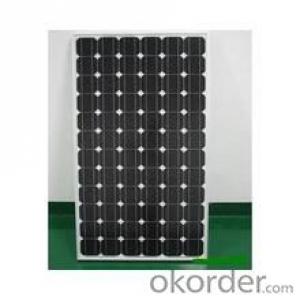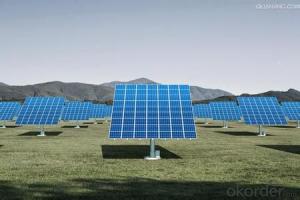NASA Monocrystalline Silicon Solar Cells 130W
- Loading Port:
- China Main Port
- Payment Terms:
- TT OR LC
- Min Order Qty:
- -
- Supply Capability:
- -
OKorder Service Pledge
Quality Product, Order Online Tracking, Timely Delivery
OKorder Financial Service
Credit Rating, Credit Services, Credit Purchasing
You Might Also Like
Quick Details
| Size: | |||||
| Max. Power: |
Specifications
Monocrystalline Silicon Solar Cells with Lowest Prices, Best Selection, Fast Shipping, Friendly Customer Service
FEATURES:
Specification
Cell: Monocrystalline Silicon Solar Cells
156mm*156mm
Dimension: 1482*676*35mm
Weight: 12kg
Characteristics
Open circuit voltage(Voc): 21.6V
Optimum operating voltage(Vmp):17.2V
Short circuit current(Isc): 8.40A
Optimum operating current(Imp): 7.56A
Maximum power at STC(Pm): 130Wp
- Q: How do solar cells perform in areas with high levels of humidity?
- Solar cells generally perform slightly less efficiently in areas with high levels of humidity. The moisture in the air can reduce the amount of sunlight reaching the cells and increase the chances of dust and dirt accumulation on the surface, both of which can hinder their performance. However, technological advancements have been made to mitigate these effects, and solar cells can still generate significant electricity even in humid regions.
- Q: How do solar cells perform in regions with high levels of salt spray and corrosive environments?
- Solar cells generally do not perform well in regions with high levels of salt spray and corrosive environments. The salt particles can accumulate on the surface of the solar cells, leading to reduced efficiency and decreased performance. Additionally, the corrosive nature of the environment can cause damage to the materials and components of the solar cells, further impacting their functionality. To mitigate these issues, special protective coatings or materials can be used to enhance the durability and resistance of solar cells in such regions.
- Q: How much energy can a solar cell generate?
- A solar cell can generate varying amounts of energy depending on factors such as its size, efficiency, and the amount of sunlight it receives. On average, a standard solar cell can produce around 200 to 400 watts of power per square meter under ideal conditions. However, advancements in technology continue to increase the efficiency and output of solar cells, allowing for even greater energy generation in the future.
- Q: Can solar cells be used to power electric vehicle charging stations?
- Yes, solar cells can be used to power electric vehicle charging stations. Solar panels convert sunlight into electricity, which can then be used to charge electric vehicles. This is known as solar-powered EV charging infrastructure, and it offers a sustainable and renewable energy solution for electric vehicle owners.
- Q: What is the role of silicon in solar cells?
- The role of silicon in solar cells is to act as a semiconductor material that can absorb sunlight and convert it into electricity through the photovoltaic effect. Silicon is the most commonly used material in solar cell manufacturing due to its abundance, stability, and ability to efficiently convert sunlight into electricity. It forms the basis of the p-n junction, which allows for the separation and movement of electrons and holes, generating an electric current.
- Q: Where can I find more information about the work process of solar cells
- The working process of solar cell is a bit complicated to describle.
- Q: How do solar cells perform in areas with high levels of light pollution?
- Solar cells perform less efficiently in areas with high levels of light pollution. Light pollution not only reduces the amount of natural sunlight reaching the solar cells but also introduces artificial light sources that can interfere with the cell's ability to absorb and convert sunlight into electricity. As a result, the overall performance and energy output of solar cells are compromised in such areas.
- Q: How do solar cells perform in areas with high levels of air pollution?
- Solar cells can experience a decrease in performance in areas with high levels of air pollution due to reduced sunlight reaching the surface of the cells. The presence of pollutants in the atmosphere can block or scatter sunlight, leading to a decrease in the amount of energy that can be converted by the solar cells.
- Q: What are the main components of a solar cell?
- The main components of a solar cell are a semiconductor material, typically silicon, which absorbs sunlight and generates electricity; metal contacts that collect and carry the generated electricity; and a protective layer, usually made of glass or plastic, to shield the semiconductor material from external factors.
- Q: How do solar cells perform in humid climates?
- Solar cells can still perform efficiently in humid climates. However, high humidity levels can slightly reduce the overall performance of solar cells due to the moisture in the air. The moisture can create a thin film on the surface of the solar panels, which reduces the amount of sunlight that can be absorbed by the cells. Additionally, increased humidity can also affect the electrical connections and can potentially lead to corrosion or damage over time. Nonetheless, advancements in solar cell technology, such as anti-reflective coatings and improved waterproofing, have helped mitigate the impact of humidity on solar cell performance.
Send your message to us
NASA Monocrystalline Silicon Solar Cells 130W
- Loading Port:
- China Main Port
- Payment Terms:
- TT OR LC
- Min Order Qty:
- -
- Supply Capability:
- -
OKorder Service Pledge
Quality Product, Order Online Tracking, Timely Delivery
OKorder Financial Service
Credit Rating, Credit Services, Credit Purchasing
Similar products
Hot products
Hot Searches
Related keywords
























